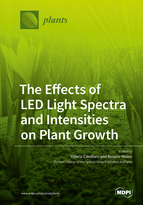The Effects of LED Light Spectra and Intensities on Plant Growth
A special issue of Plants (ISSN 2223-7747). This special issue belongs to the section "Plant Physiology and Metabolism".
Deadline for manuscript submissions: closed (31 March 2022) | Viewed by 84340
Special Issue Editors
Interests: plant micropropagation; seed dormancy and germination; abiotic stress; conservative agriculture
Special Issues, Collections and Topics in MDPI journals
Interests: light quality perception and photoregulation of plant development in plant micropropagation and during plant changing phase; genetic, epigenetic, and molecular physiology of plant stress tolerance and plant adaptation to ambience; genetic and molecular physiology of flower and fruit development and accumulation of secondary metabolites
Special Issues, Collections and Topics in MDPI journals
Special Issue Information
Dear Colleagues,
The physical properties of light as spectral quality, irradiance and intensity, and photoperiod play a deep role on the morphogenesis, growth, and metabolism of many biochemical pathways in plants.
Light‐emitting diodes (LEDs) have been demonstrated to offer interesting prospects for use in plant lighting designs in controlled environment agriculture (greenhouses) and growth chambers for in vitro cultures.
As compared to the previously used light sources, LEDs possess advantages such as wavelength specificity, less heat radiation, longest durability, much lower power consumption, and the possibility to manipulate the spectral qualities of the emitted light.
In high-technology greenhouses, supplemental light provides the opportunity to optimize lighting photosynthetic efficiency, through the possibility of optical regulation of plant photoreceptors to enhance the efficiency of plant production, and the synthesis and accumulation of plant metabolites for obtaining products with improved nutritional properties.
‘’In vitro’’ culture is regulated by different factors, and among them light is most important. LED illumination system for ‘‘in vitro’’ cultures should provide light in the spectral region that is involved in photosynthesis and photomorphogenic responses without wasting energy on nonproductive wavelengths. The combined effects of light and growth regulators or other components of the culture media is another important issue. Even on in vitro cultures, LED light may regulate gene expression and physiological behaviour that in turn influences metabolite productions.
This Special Issue of Plants will concern the effects of LED quality and spectral composition on plant physiological and morphological traits, metabolite production, and productive efficiency, both in vitro and/or in confined environment cultivation.
Dr. Valeria Cavallaro
Dr. Rosario Muleo
Guest Editors
Manuscript Submission Information
Manuscripts should be submitted online at www.mdpi.com by registering and logging in to this website. Once you are registered, click here to go to the submission form. Manuscripts can be submitted until the deadline. All submissions that pass pre-check are peer-reviewed. Accepted papers will be published continuously in the journal (as soon as accepted) and will be listed together on the special issue website. Research articles, review articles as well as short communications are invited. For planned papers, a title and short abstract (about 100 words) can be sent to the Editorial Office for announcement on this website.
Submitted manuscripts should not have been published previously, nor be under consideration for publication elsewhere (except conference proceedings papers). All manuscripts are thoroughly refereed through a single-blind peer-review process. A guide for authors and other relevant information for submission of manuscripts is available on the Instructions for Authors page. Plants is an international peer-reviewed open access semimonthly journal published by MDPI.
Please visit the Instructions for Authors page before submitting a manuscript. The Article Processing Charge (APC) for publication in this open access journal is 2700 CHF (Swiss Francs). Submitted papers should be well formatted and use good English. Authors may use MDPI's English editing service prior to publication or during author revisions.
Keywords
- gene expression
- physiological regulation
- photoreceptors
- photobiology
- photomorphogenesis
- LEDs
- spectral composition
- light intensity
- in vitro culture
- confined environment
- productive efficiency
- metabolites production








